Article's Content
Welcome to Volume 72!
Creating content that generates millions in sales or backlinks doesn’t happen by accident.
It happens when you prioritize research and distribution.
This is how you truly shape culture, inspire actions, and impact your bottom line.
Invest time researching and creating content that your audience would find valuable enough to share, and distribute that piece of content forever. That’s our growth strategy.
Before we dive into today’s stories, here’s a peek at what’s to come in this piece:
- Conductor Acquires ContentKing
- Why We Love MailChimp’s Bloom Season
- New Research Reveals Tips To Beat Google Algorithm
Conductor Acquires ContentKing
I woke up last week to this announcement on LinkedIn:
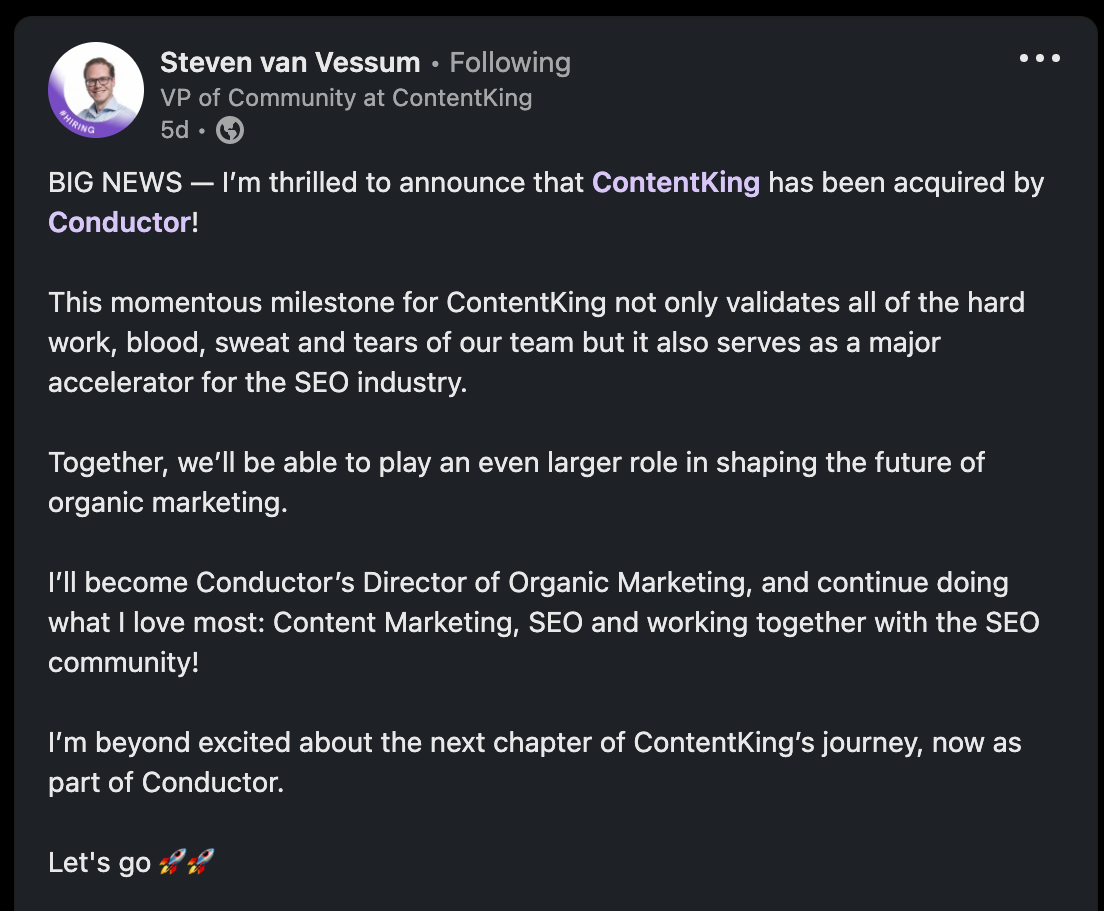
Enterprise SEO and Content Marketing software, Conductor acquired Content King, a real-time SEO Auditing and Monitoring Platform.
The Organic Marketing Leader invested an undisclosed amount from its latest funding round to bring the Technical SEO Leader onboard. The goal is to establish greater leadership in the technical SEO space and improve collaboration between teams to drive better results in organic marketing within enterprise organizations.
Conductor has thrown itself into helping enterprise leaders like Twitter record greater organic marketing successes across their organization.
The organic marketing leader’s efforts haven’t gone unnoticed. Conductor was the top-rated SEO platform in Forrester Wave 2020 Report, and they have been rated #1 on TrustRadius and G2Crowd by enterprise marketers.
Beyond being a trusted platform, Conductor also leads by example. They have invested in building authority around content marketing and non-technical SEO keywords.
Here’s what its search scorecard looks like:
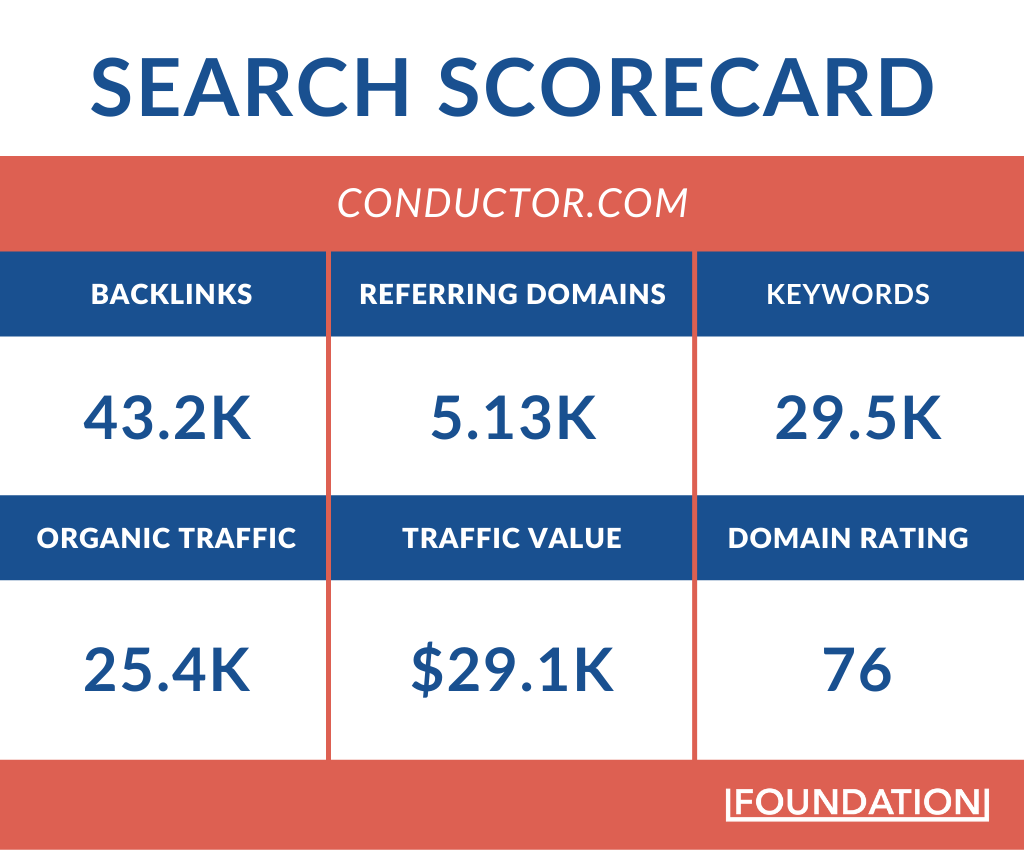
When I dug deeper, I found that 50% of Conductor’s traffic comes from its learning center.
Conductor’s learning center houses all of its content assets, ranging from reports, guides, glossary terms, and other content types.
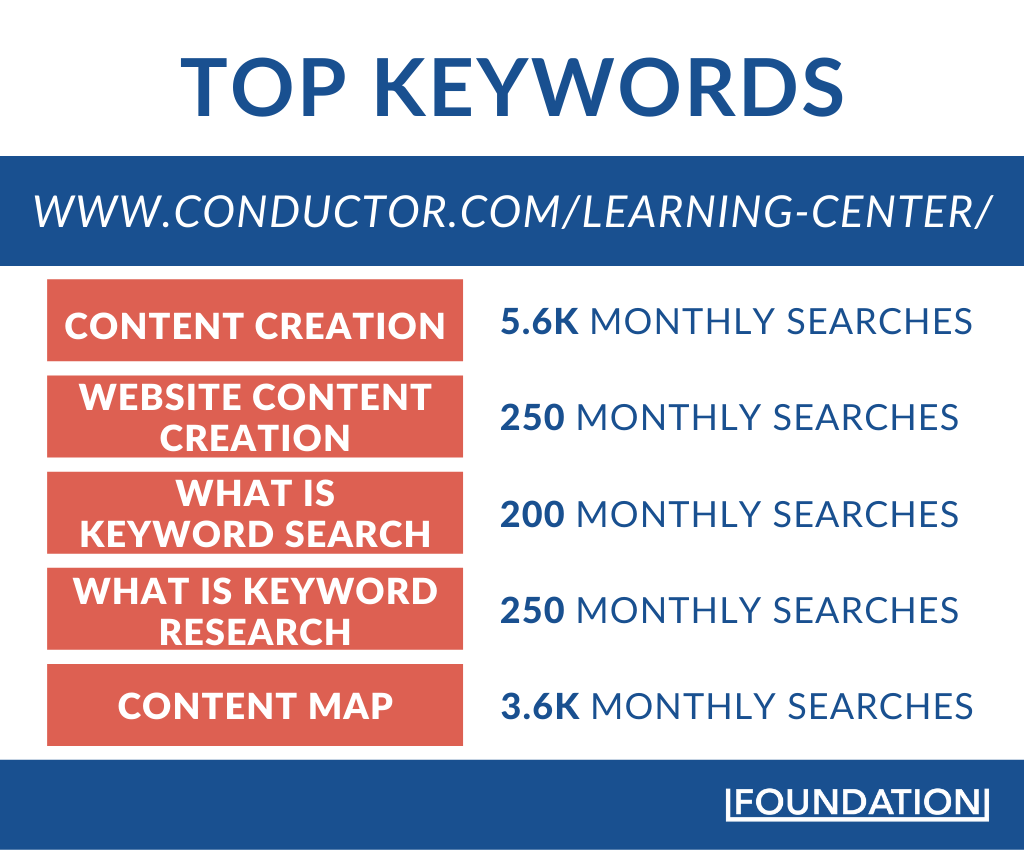
The top performing keywords show that Conductor has made some strides dominating the SERPs for a combination of high-value and long-tail content marketing keywords.
Of course, Conductor’s numbers aren’t as high as Grammarly’s or Hubspot’s, but it’s still pretty good, and it’s about to get even better with ContentKing onboard.
ContentKing has done pretty well positioning itself as a technical SEO leader, an achievement that aligns with Conductor’s goal of becoming a leader in tech SEO.
Here’s what their search scorecard looks like:
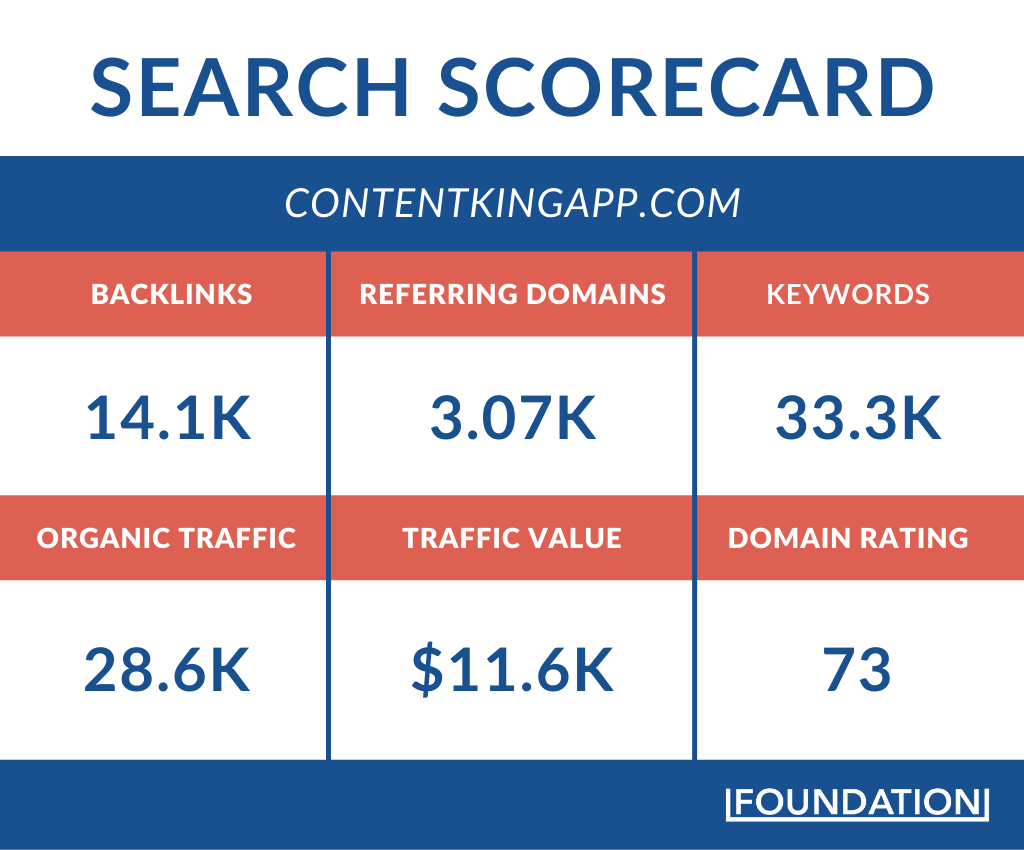
Over 90% of ContentKing’s search traffic value comes from its academy. Instead of going after hard keywords, they targeted long tail technical SEO keywords, and they dominate the SERPs for most of these keywords:
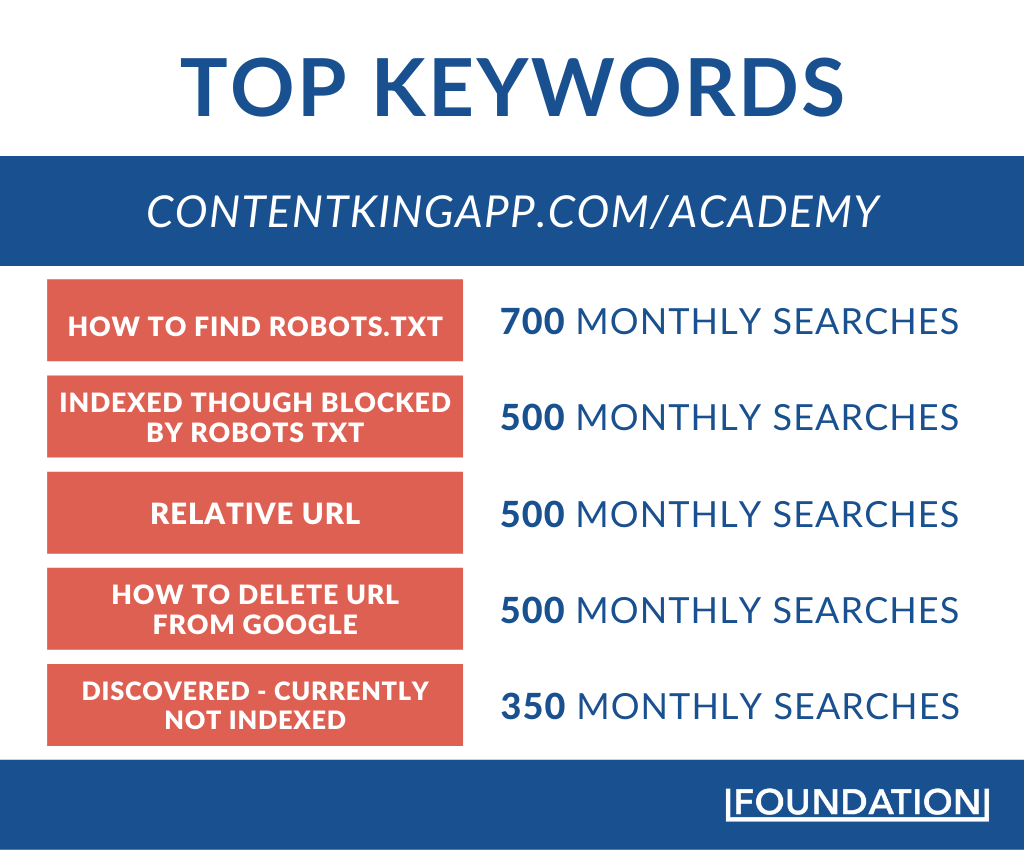
Most of these glossary terms appear in the featured snippets of the SEO, attracting tons of technical and non-technical SEO people looking to learn more about these terms.
Of course, we know long-tail keywords don’t generate much traffic compared to general search queries. However, they have a higher search intent and conversion potential as they address specific questions or issues prospects need to solve.
Going up against industry giants who already rank for high-value keywords is a no-brainer and a waste of resources, especially for a startup.
You want to invest your resources in building a better product and attracting more qualified leads through your marketing efforts. The lower the search volume and competition, the higher the potential for conversion.
Beyond organic search, ContentKing has done pretty well in its six years of existence. Last year alone, the company bagged G2 Enterprise Recognition and tons of other badges in the fall report:
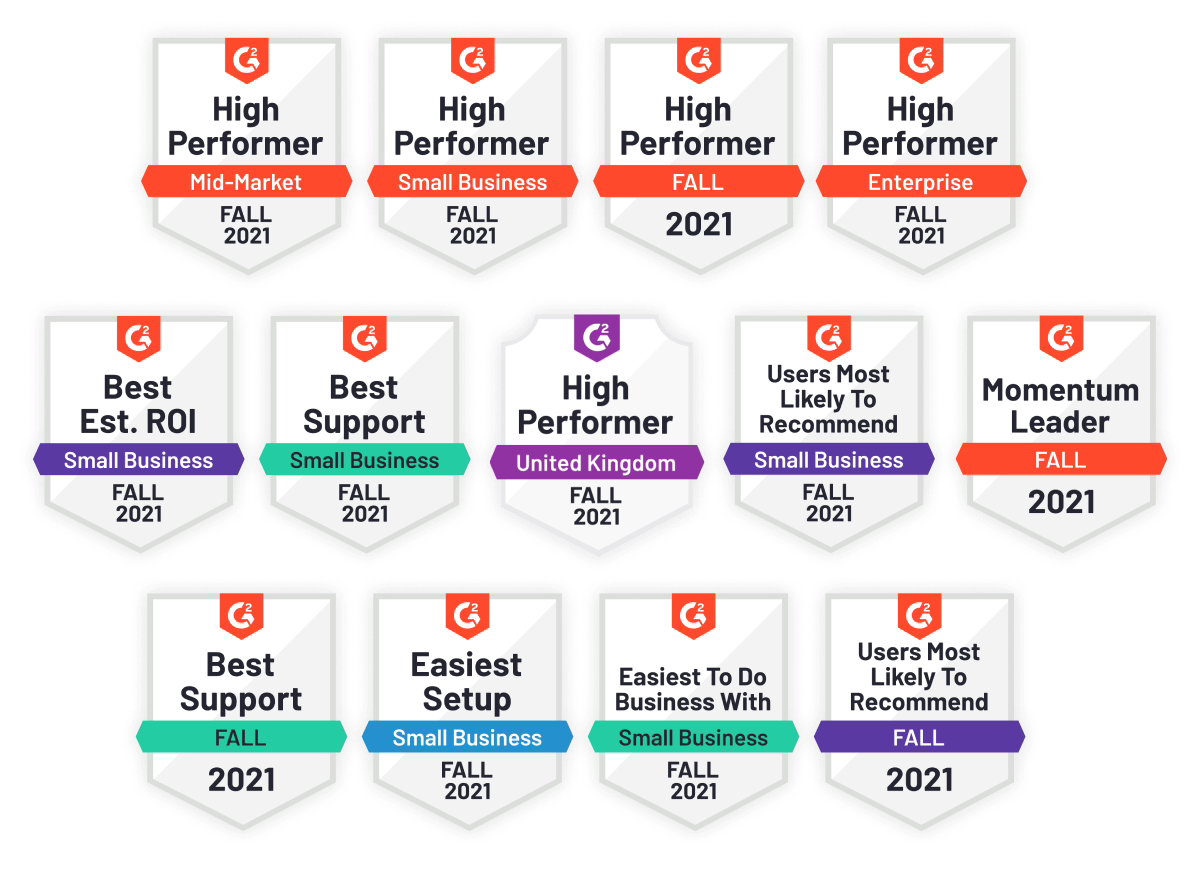
Conductor definitely saw that its journey to dominating the tech SEO space would be a lot faster with ContentKing. So, instead of attempting to build from scratch, they put their money where their mouth is, just like Semrush and Backlinko’s acquisition.
I believe that bringing ContentKing and its team under Conductor’s umbrella positions the platform better as an authority in the space and an all-in-one solution for marketers.
KEY TAKEAWAYS:
- Organic Marketing Leader, Conductor acquired Content King, a real-time SEO Auditing and Monitoring Platform for an undisclosed amount.
- The goal is to establish greater leadership in the technical SEO space and drive better results in organic marketing for enterprise brands.
- Over 90% of ContentKing’s search traffic value comes from its academy where they dominate the SERPs for long-tail technical SEO keywords.
- Long-tail keywords don’t generate much traffic, compared to general search queries. However, they have a higher search intent and conversion potential
- Conductor x ContentKing positions the brand to dominate the tech SEO space and serve their enterprise clients better
Why We Love MailChimp’s Bloom Season
MailChimp and Co-founder, Ben Chestnut took to Twitter to announce Bloom Season’s launch:
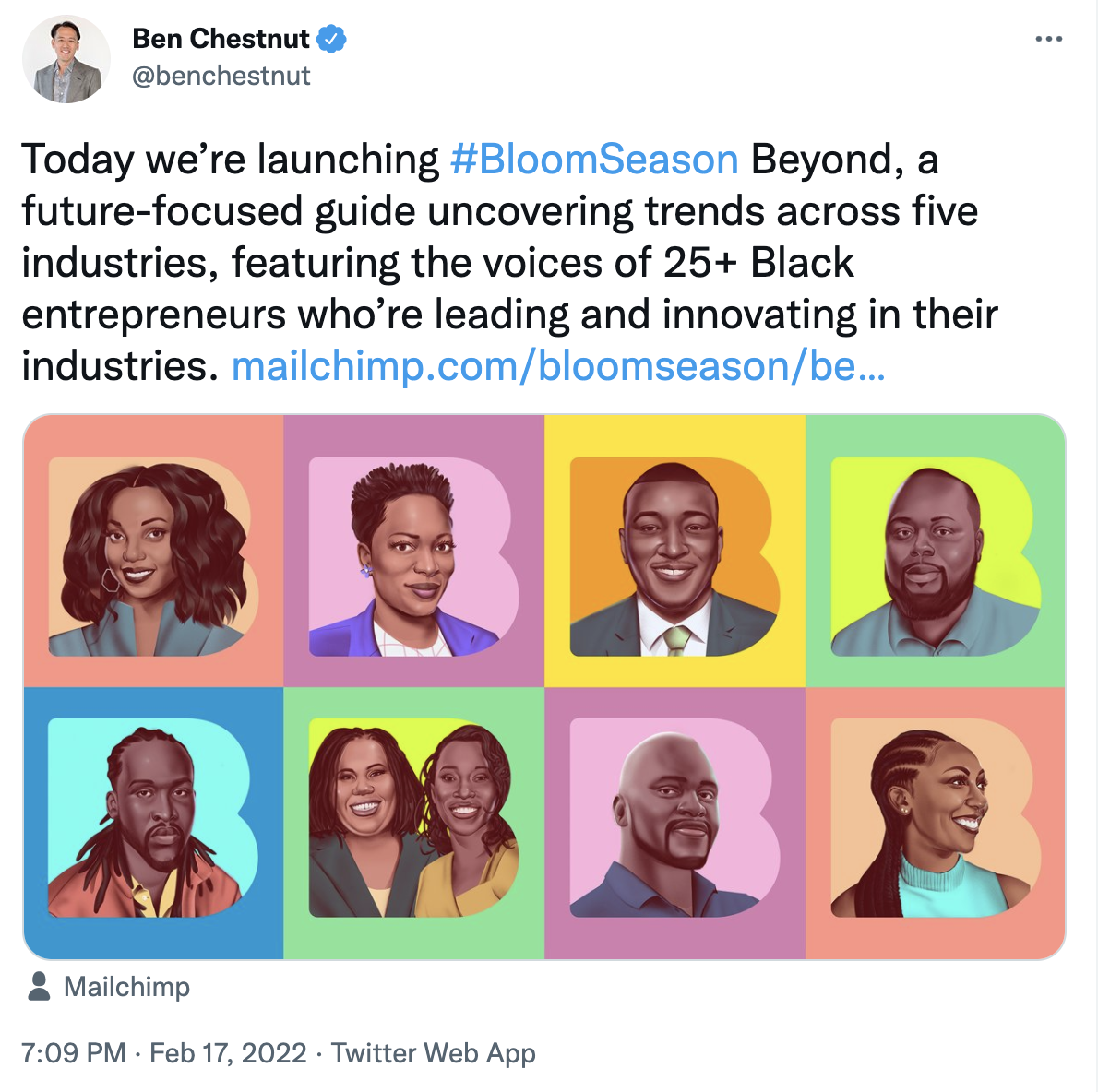
Bloom Season is MailChimp’s digital magazine that empowers black-owned small businesses in specific industries, with practical tips from successful black entrepreneurs, to reshape how these businesses think of success.
Since the launch, Bloom Season has received some love on Twitter, especially with its debut in Black History Month. Like this shout-out:
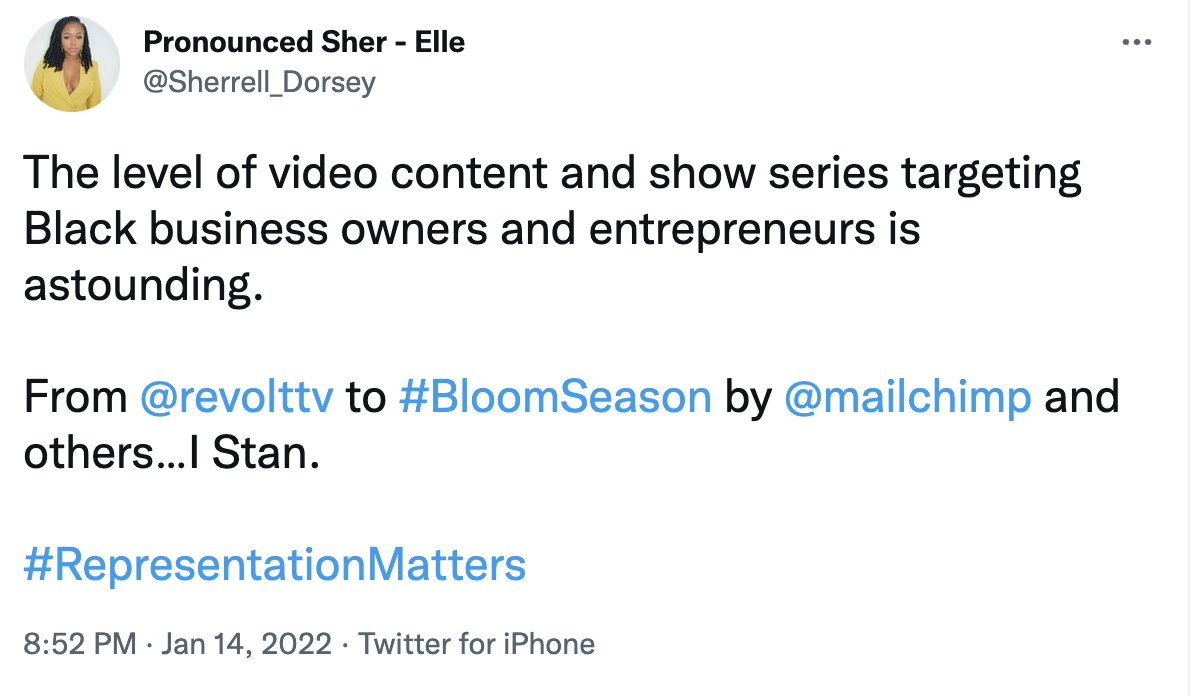
While we applaud MailChimp for such a great initiative, we admire the creativity and content excellence of the project even more.
The interactive nature of Bloom season shows MailChimp embraces design and content excellence. Take a look at the featured image for one of its blog posts:

The featured image alongside the caption gives clear direction and sets expectations for readers. I don’t know about you, but I’m a sucker for great content and design.
The font size and format used throughout the blog post make reading easy on the eye and enjoyable.
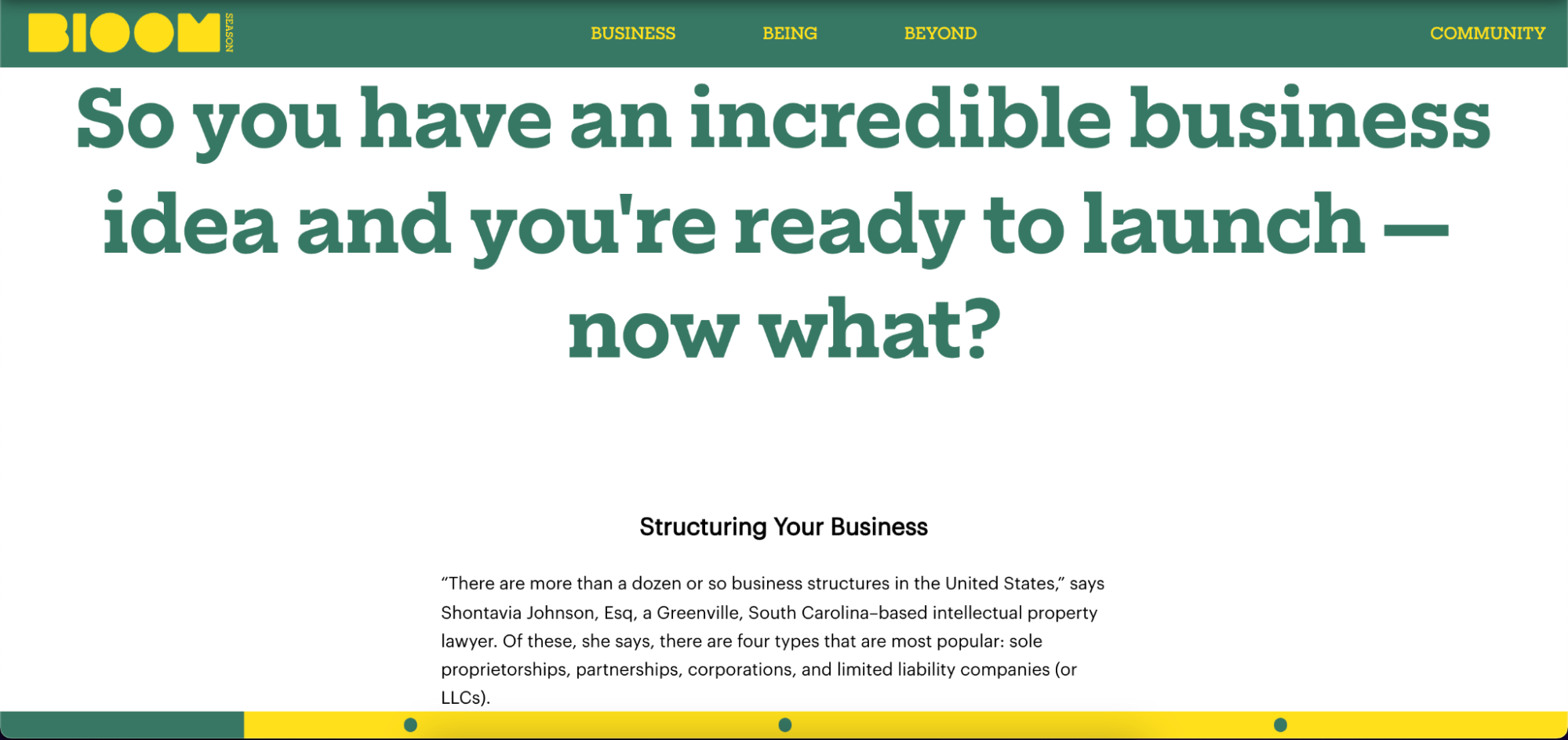
You don’t have to scroll too far to get the info you need.
MailChimp also avoids fluffy content and focuses on sharing creating thought leadership pieces on business, overall wellbeing, and other fun areas small businesses will find valuable. Here are some content pieces they have produced in each category:
- Money Moves (Business/Finance)
- From URL to IRL (Business/Marketing)
- Therapy for Black Entrepreneurs (Wellbeing/Mental Health)
- Perfecting The Pivot (Business/Success Story)
- The Mentorship Manual (Business/Mentoring)
- Avoiding Burnout (Wellbeing/Self Care)
These are real topics people, including entrepreneurs go on Google to search for.
A topic like burnout, for instance, has 433K people searching for related content every month.

Having an entrepreneur who can relate to this pain share first-hand experience is a great way to help their readers connect with the story, find the help they need and share it with their network.
Also, MailChimp ensures these content pieces are short, sweet, and straight-to-the-point.
They understand that small business owners are busy. They wear many hats trying to ensure their business succeeds. As a result, these owners sometimes skim content to pick important key points. Or read on their way to their next appointment.
So, MailChimp made reading easier by also using a presentation-style format to help readers with the most important points in sections they are interested in.
Like this one:

You can hover and click on any of the sections you want to read without spending so much time on one subject.
User experience (UX) goes beyond how well-designed a website looks.
UX includes your copy, design, CTAs, site structure, and the overall vibe users get from interacting with your content. For me, MailChimp nailed Bloom Season’s UX, and we look forward to seeing what it evolves to become in the coming months.
KEY TAKEAWAYS:
- MailChimp launched Bloom season empower entrepreneurs of color to build successful small businesses.
- The interactive nature of Bloom season shows MailChimp embraces the power of design and content excellence.
- MailChimp embraced a presentation-style format to make it easy for busy small business owners to grab key takeaways from each content piece, without looking too hard or spending too long.
New Research Reveals Tips to Beat Google Algorithm
Title tags are to SEO as water is to good health. These tags help search engines and people understand what your page is about. They play a critical role in determining how your page ranks on Google and the number of clicks your ranked pages get.
Zyppy studied 81,000-page titles across 2370 sites globally, and they found that Google rewrote 61.6% of them. Here’s an example of a Zyppy’s page title tag Google rewrote:
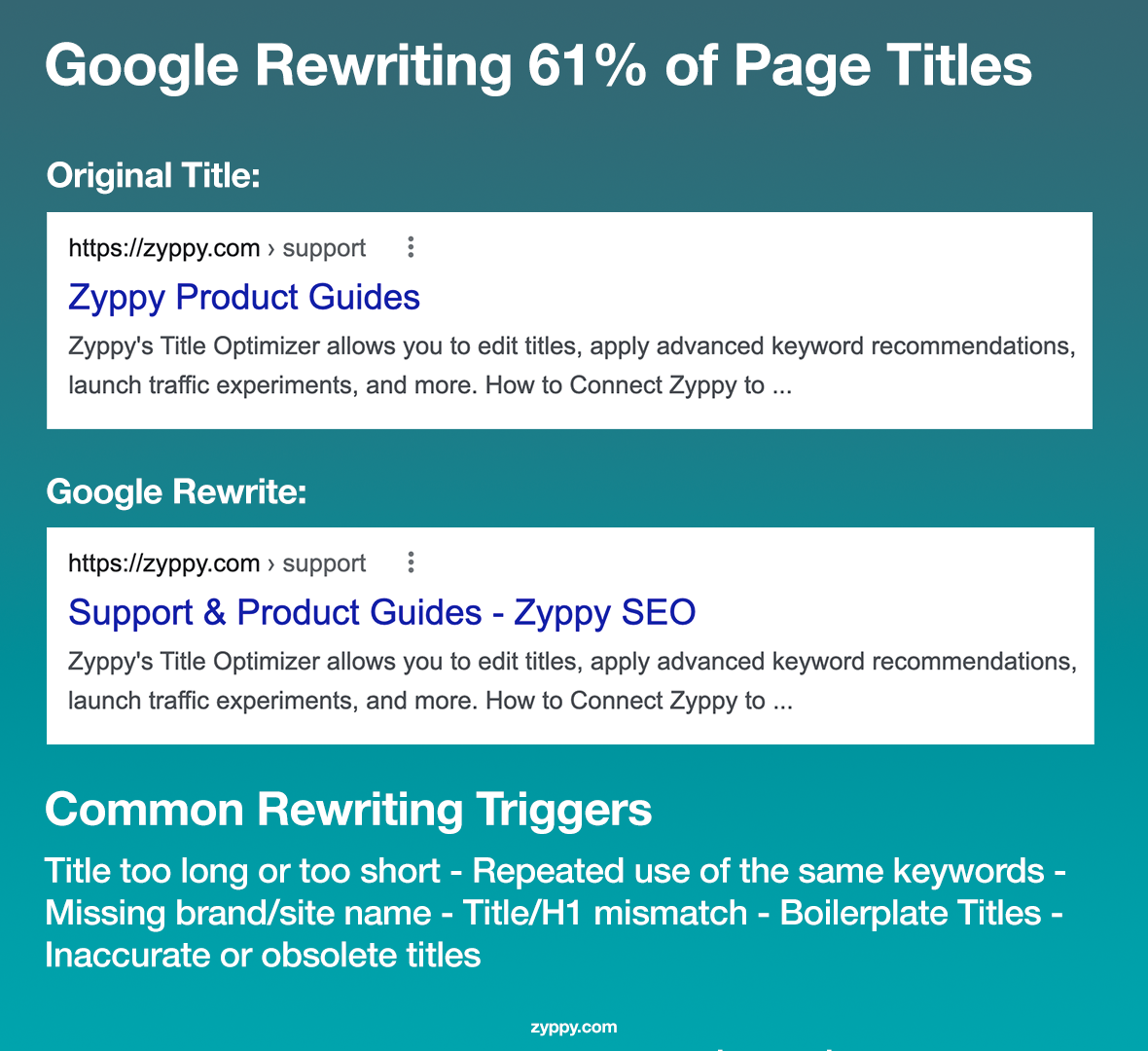
Apparently Google is now more aggressive in making changes to ranked page titles so users can get the best results and experience while researching a topic.
Zyppy found some common reasons why Google rewrites titles. We will share three of these reasons and include a tip that’d help you write better titles that’d boost your clickthrough rates.
Here we go.
1. When Your Title Is Too Long or Too Short
Zyppy found that Google rewrites both long titles and extremely short titles over 95% of the time. That’s because these titles are either less than 20 characters or over 60.

The best way to avoid having your titles rewritten is to ensure it falls somewhere between 51-60 characters.
Most desktops and mobile browsers display the first 50-60 characters. Titles longer than this range are almost always truncated with ellipses (…).
Even though the recommended length for title tags on Google isn’t set in stone yet, sticking to the 51-60 character range would be most beneficial for your SEO game. Zyppy found that titles with this length have the lowest percentage of rewrites.
Pro Tip: Always shoot for 51-60 characters when crafting titles if you want to keep Google from rewriting your titles. No more, no less.
2. When You Use Pipes “|” as a Title Separator
In addition to title length, you also want to check the separator you use. Apparently, Google cares about your choice of separator.
Zyppy’s research revealed that titles with pipes (|) as separators were rewritten 41.0% of the time, while those with dashes (- – —) were rewritten 19.7% of the time.
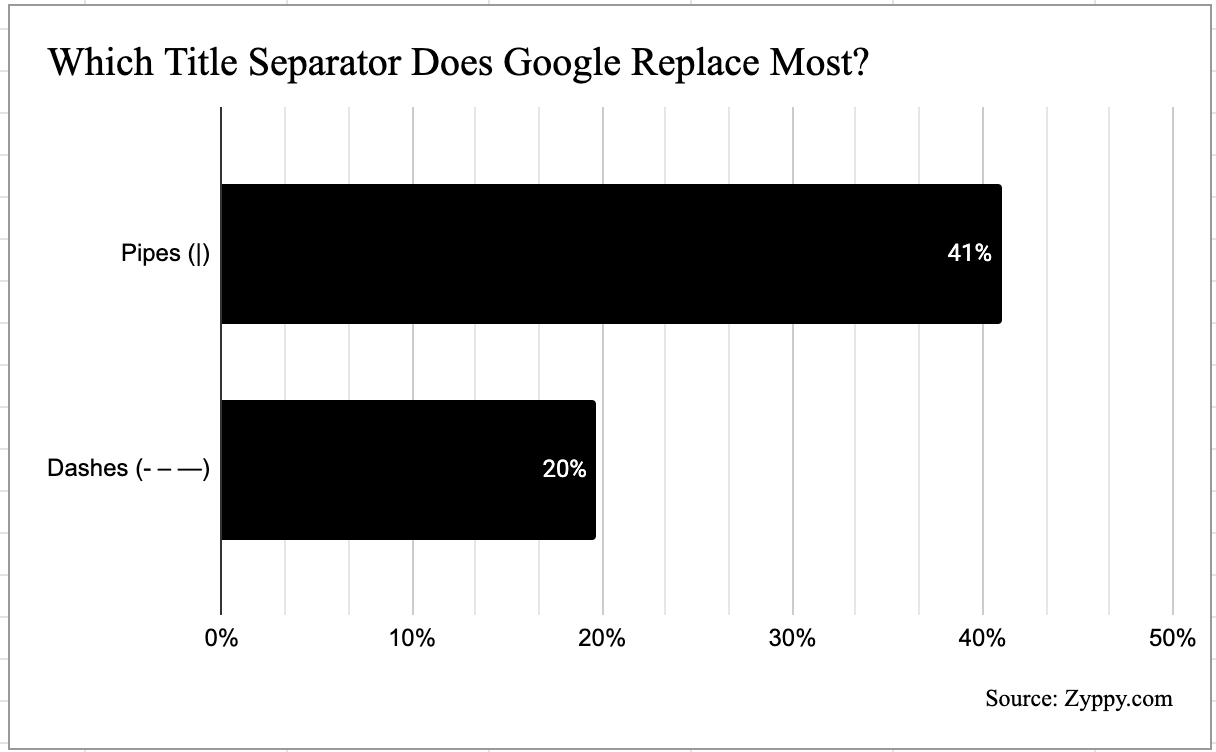
Even though using pipes won’t hurt much, leaning on dashes seems like a better way to go. Google often replaces pipes with a dash.
Pro Tip: Since pipes have a high likelihood of being replaced, you should consider using dashes (- or —) as brand name separators.
3. When You Use Titles with [Brackets]
Most people use brackets and parentheses interchangeably to emphasize text within titles. While this might work well in some places, it can trigger a rewrite from Google.
Zyppy found that Google rewrote page titles that contained brackets 77.6% of the time. They also removed the text in the bracket 33% of the time. For titles with parentheses, Google rewrote them 61.9% of the time and removed the text 20% of the time.
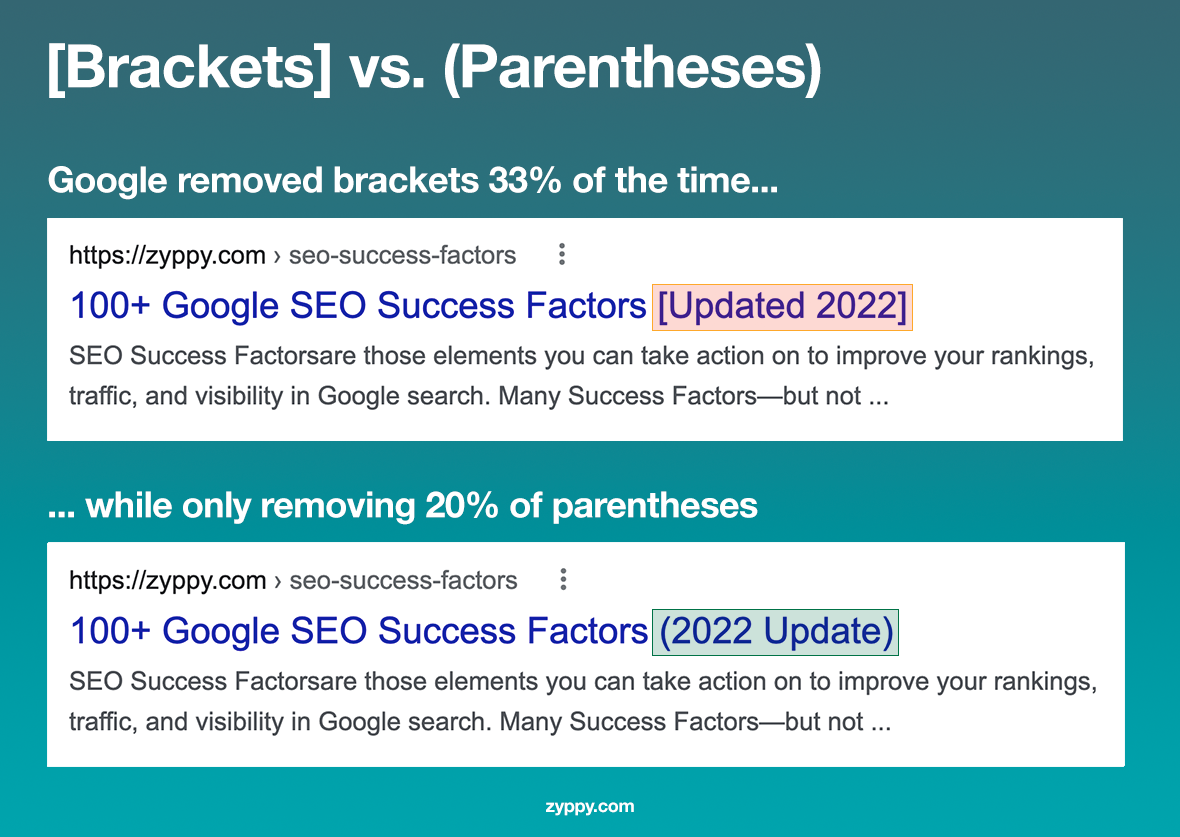
From the difference in stats, it’s advisable to emphasize text in your titles using parentheses. You can do without any brackets or parentheses to avoid having your titles rewritten.
4. Keep your titles and H1s similar
That’s another way to avoid having your title tags rewritten—use HTML tags. If the title has a number, for instance, make sure the H1 does too.
Pro Tip: Ensure your title tag as well as your H1 tag matches each other. That’d definitely help reduce the number of rewrites your titles get.
KEY TAKEAWAYS:
- Google rewrites both long titles and extremely short titles over 95% of the time. So, always shoot for 51-60 characters when crafting titles.
- You should use dashes (- or —) more as brand name separators as Google often replaces pipes with a dash.
- Emphasize text in titles using parentheses or without it, if you can. Google is less likely to tamper with the titles you’ve spent hours brainstorming.
- Limit title rewrites by using HTML tags. Ensure your title tag as well as your H1 tag matches each other.
OTHER NEWS OF THE WEEK:
📍Facebook Reels is now available worldwide, giving creators an additional channel to create short-form video content, cross-promote on Instagram, and reach more people.
📍Salesforce collaborates with AWS to empower developers to build and launch custom applications, leveraging the power of both platforms.
📍Slack went down out on Tuesday, leaving most users in the dark for most of the day.
BRAIN FOOD OF THE WEEK:
Earlier this year, Amanda Natividad rolled out a thought leadership thread on a strategy marketers should take advantage of:

Permissionless Co-Marketing is the reverse of earned media. Amanda defines it as “aligning yourself with other brands by promoting them in your work,”
In other words, instead of waiting to get paid to mention a brand you admire in your content, you do it anyway. You show your admiration and respect for their work by giving them free press.
When you mention other brands in your content, acknowledging the good things they do, you’re further establishing your authority and credibility in your space. You don’t risk losing your audience to the people you mentioned. Unless you stop being valuable.
So, when should you do permissionless co-marketing?
Amanda gives three uses cases for applying this technique
- When You Want To Elevate Your Brand: The technique is a double-edged sword—when you shout out and link to other brands, you earn relationships that could materialize into more referral traffic and other benefits.
- When You Want To Demonstrate Your Product’s Value: You can use your product to gather information about a brand’s audience and use it to promote the brand’s business and your product’s value.
- When You Want To Establish Authority As a Category Owner: You can align your product and personal brand with big names in your industry.
This graphic from SparkToro summarizes the concept perfectly:
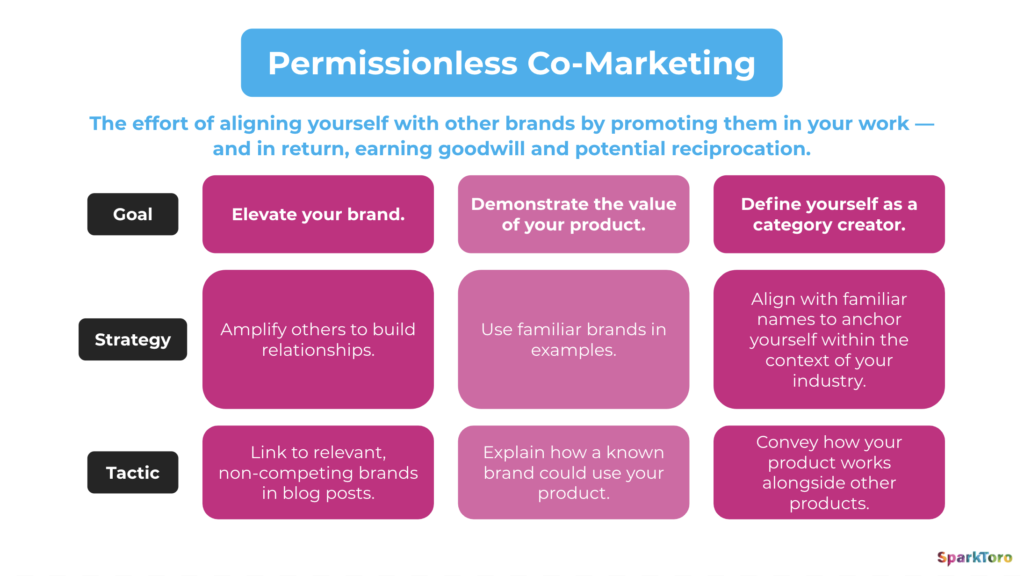
If you want to establish more authority and trust in your industry and increase your reach, you should help elevate other brands, show people the value of their product, and acknowledge their expertise.
You can read the full blog post here.
TWITTER THREAD OF THE WEEK:
9 ways marketers can use research to increase the likelihood of content success by Ross Simmonds
IN CASE YOU MISSED SOME OF OUR GREATEST HITS:
- How Toast’s $12M+ SEO Moat Helped Them Grow During a Pandemic
- Write Better Headlines, From The Pros At LinkedIn
- How To Create Content For Search And Humans
- ShipBob Billion-Dollar Social Proof Formula
WHAT WE’RE WIRED INTO THIS WEEK 🎧:
These round-ups are brought to you by me, Jessica O., every week ✌!







